Abstract
The data collected in Hiroshima and Nagasaki during the past 40 years on the children of survivors of the atomic bombings and on the children of a suitable control population are analyzed on the basis of the newly revised estimates of radiation doses. No statistically significant effects emerge with respect to eight different indicators. Since, however, it may confidently be assumed some mutations were induced, we have taken the data at face value and calculated the minimal gametic doubling doses of acute radiation for the individual indicators at various probability levels. An effort has also been made to calculate the most probable doubling dose for the indicators combined. The latter value is between 1.7 and 2.2 Sv. It is suggested the appropriate figure for chronic radiation would be between 3.4 and 4.5 Sv. These estimates suggest humans are less sensitive to the genetic effects of radiation than has been assumed on the basis of past extrapolations from experiments with mice.
Full text
PDF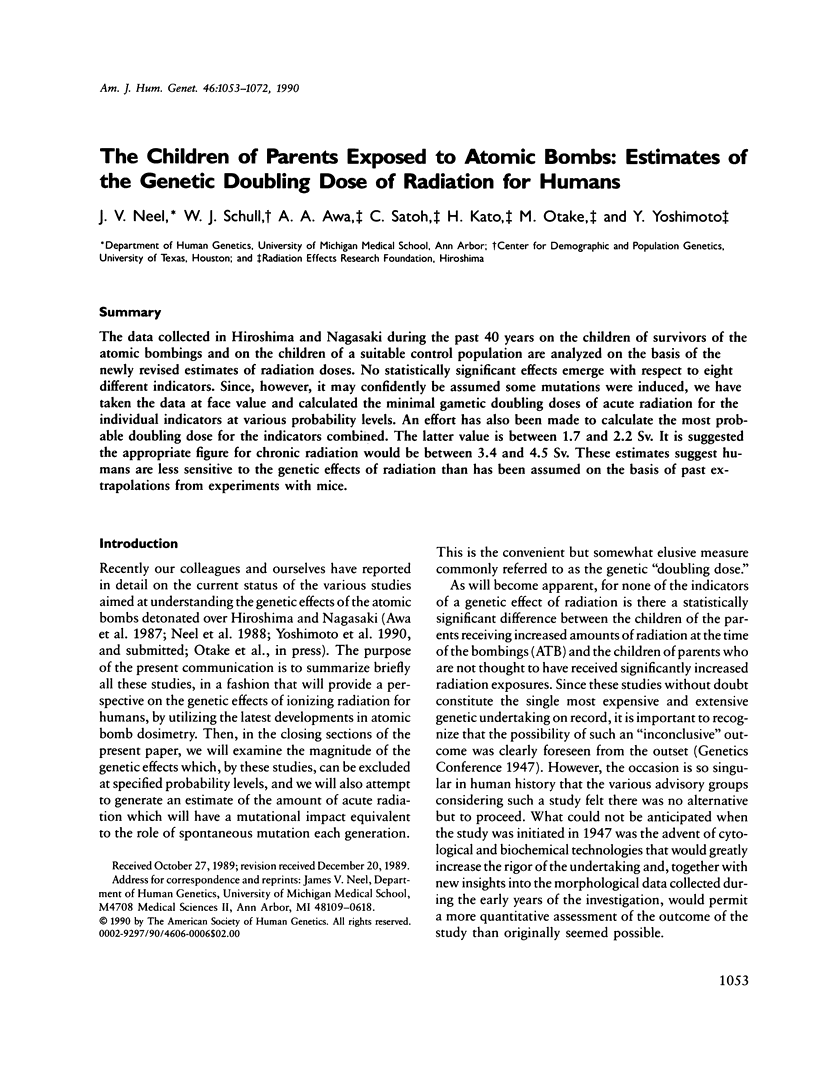
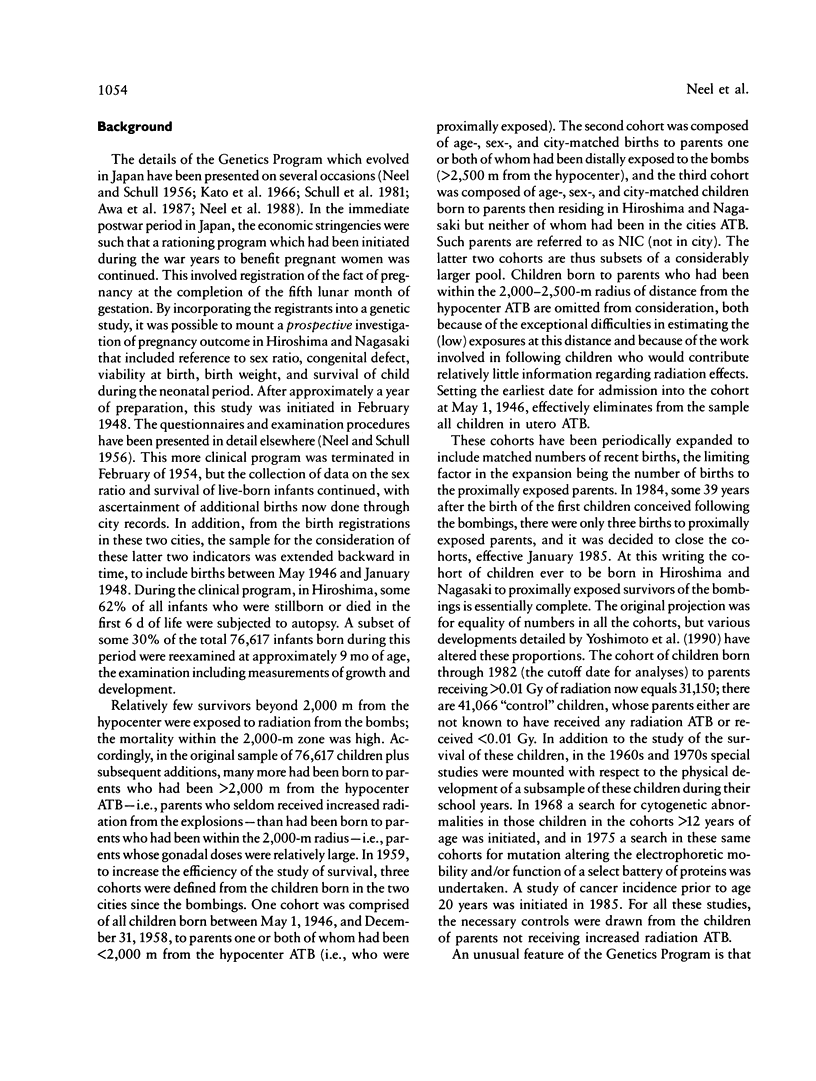
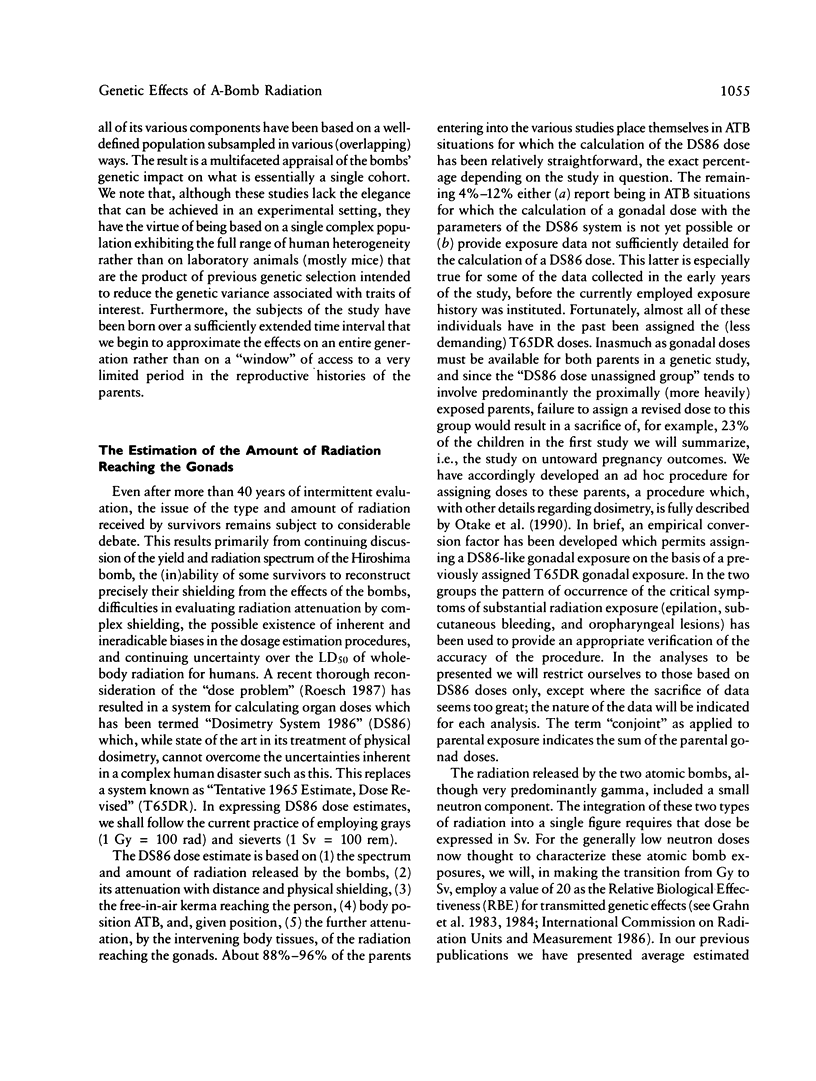
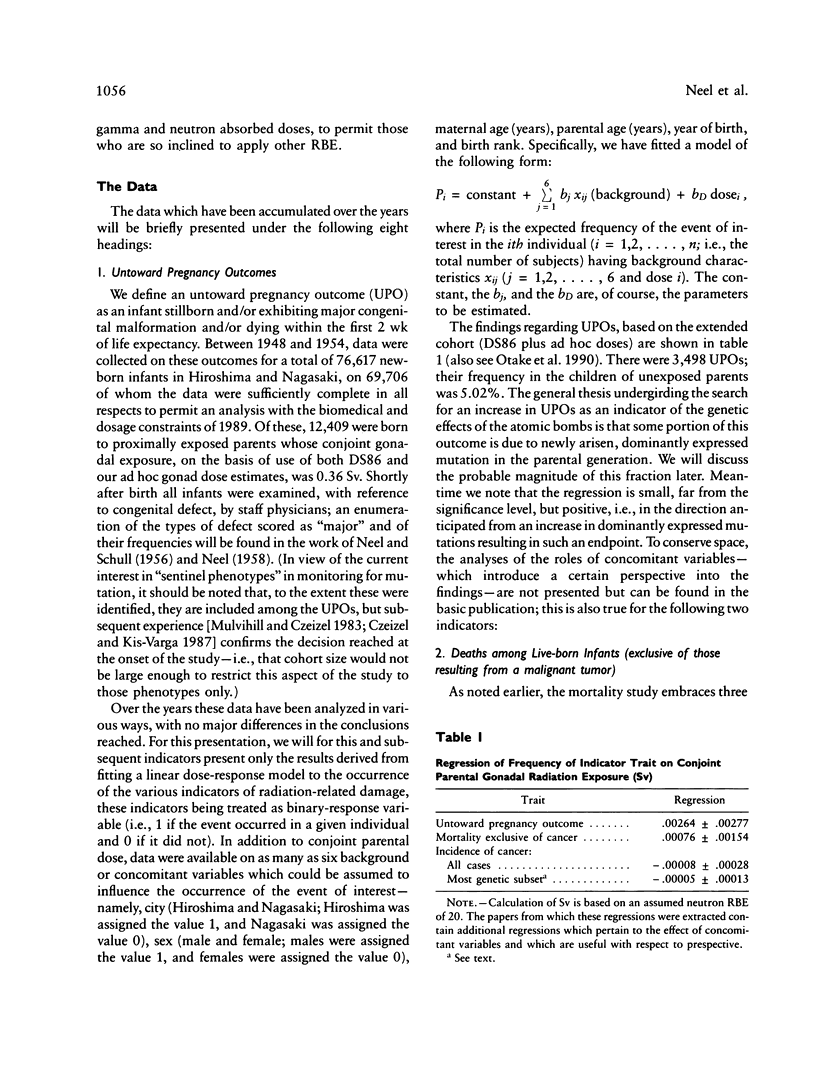
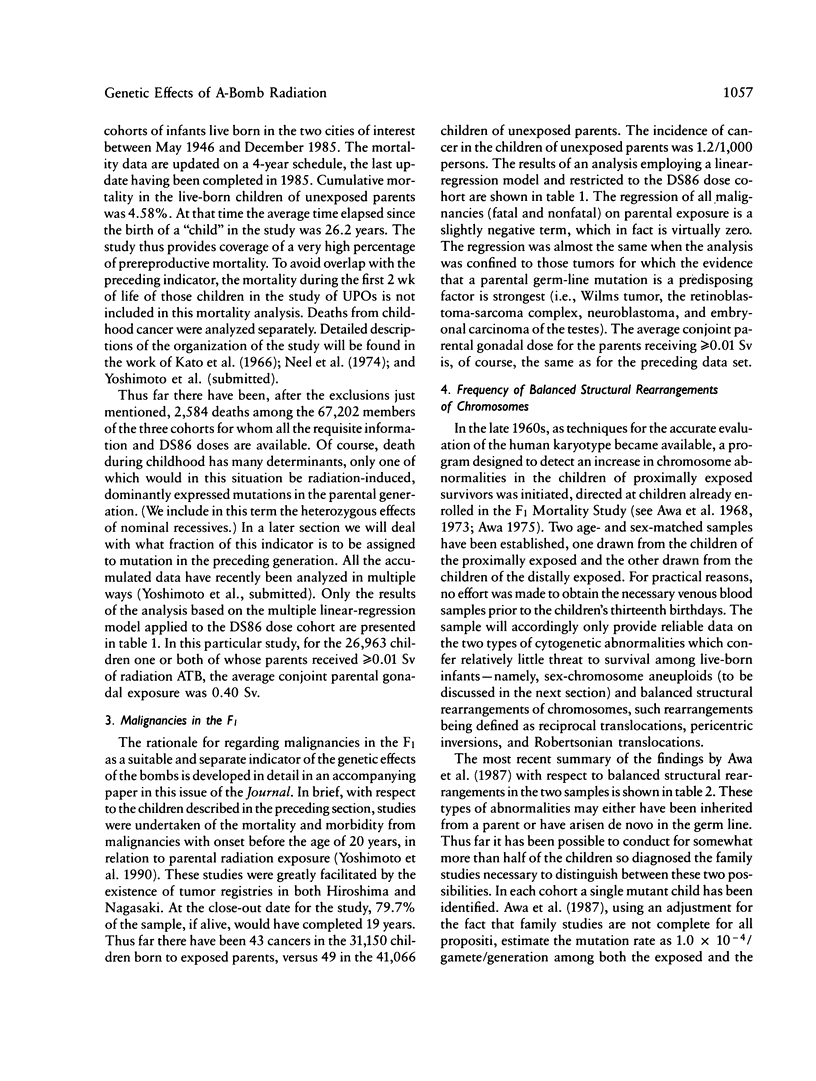
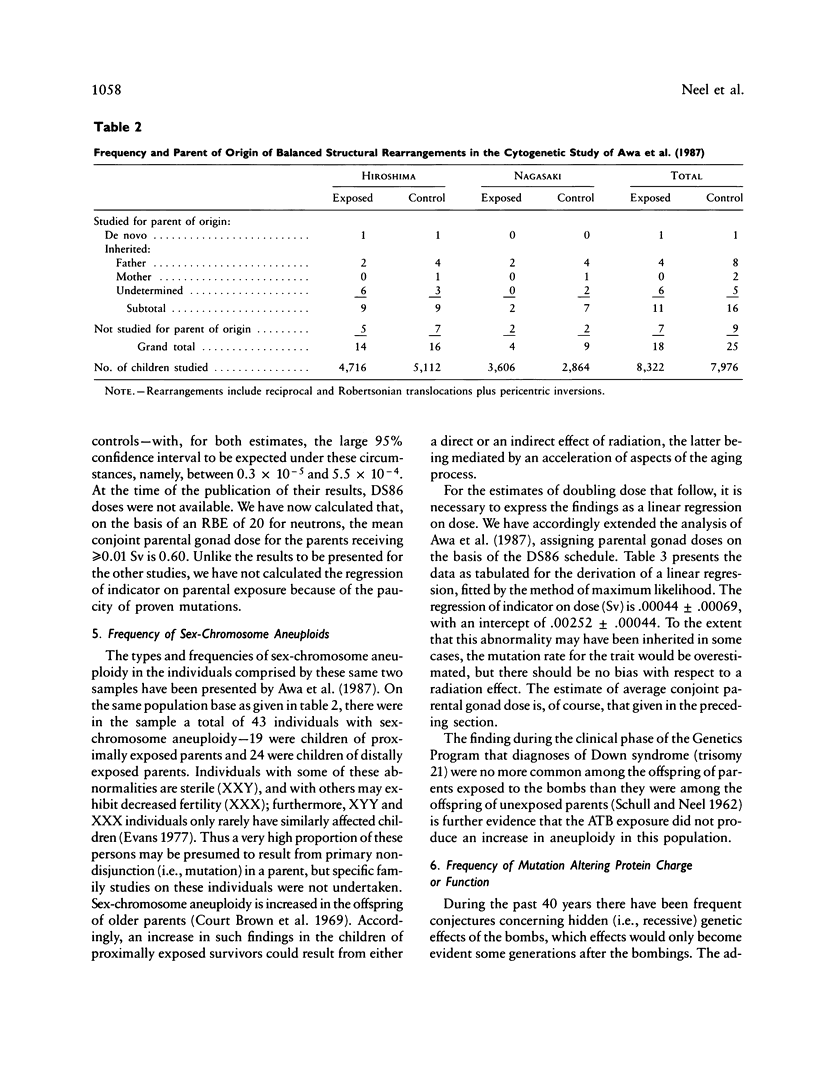
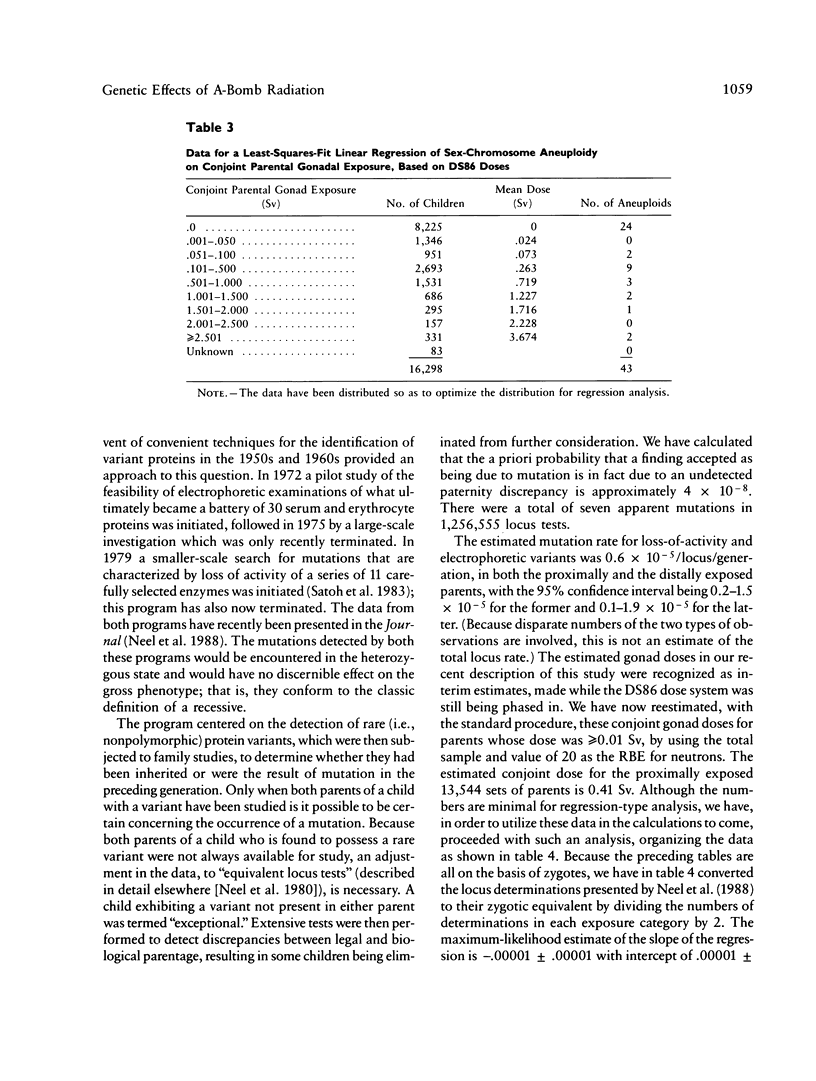
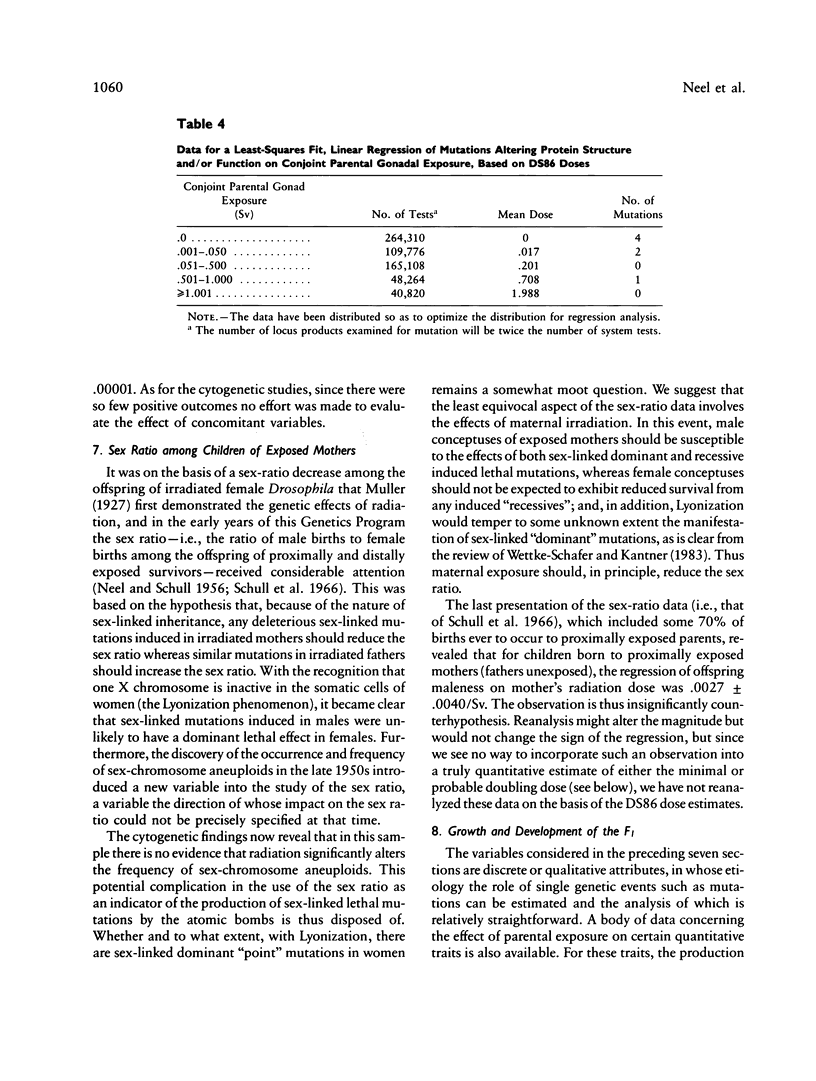
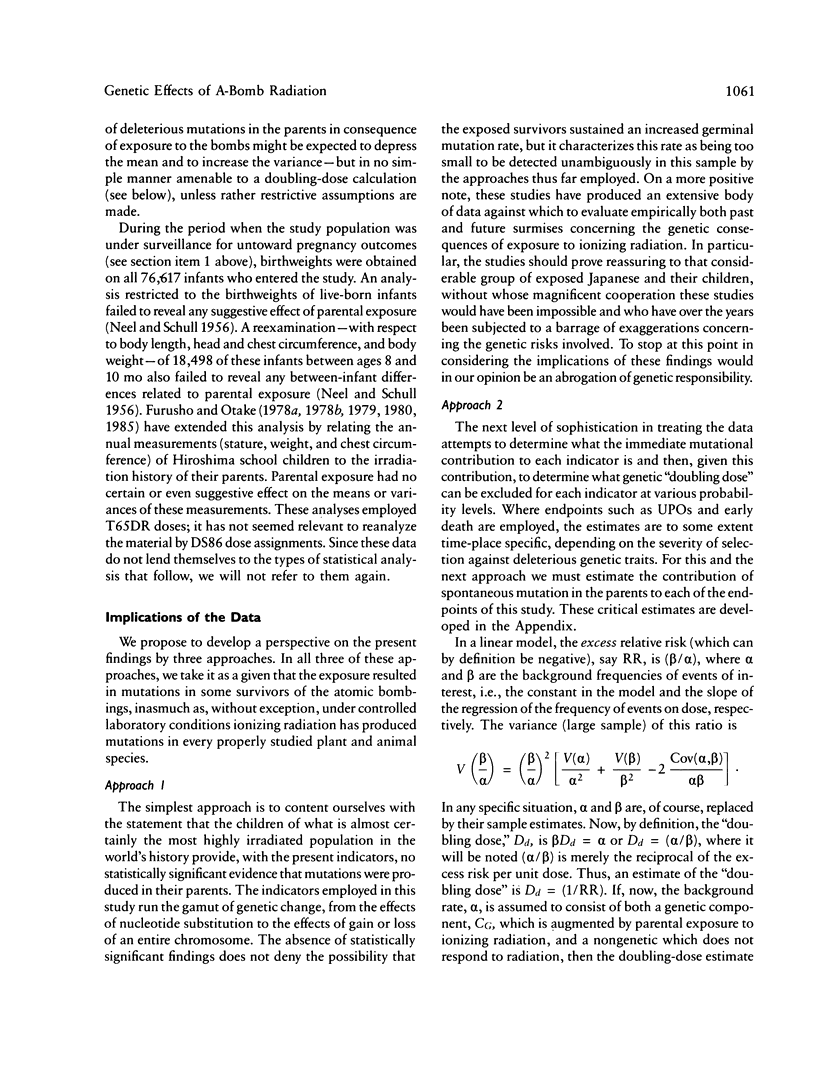

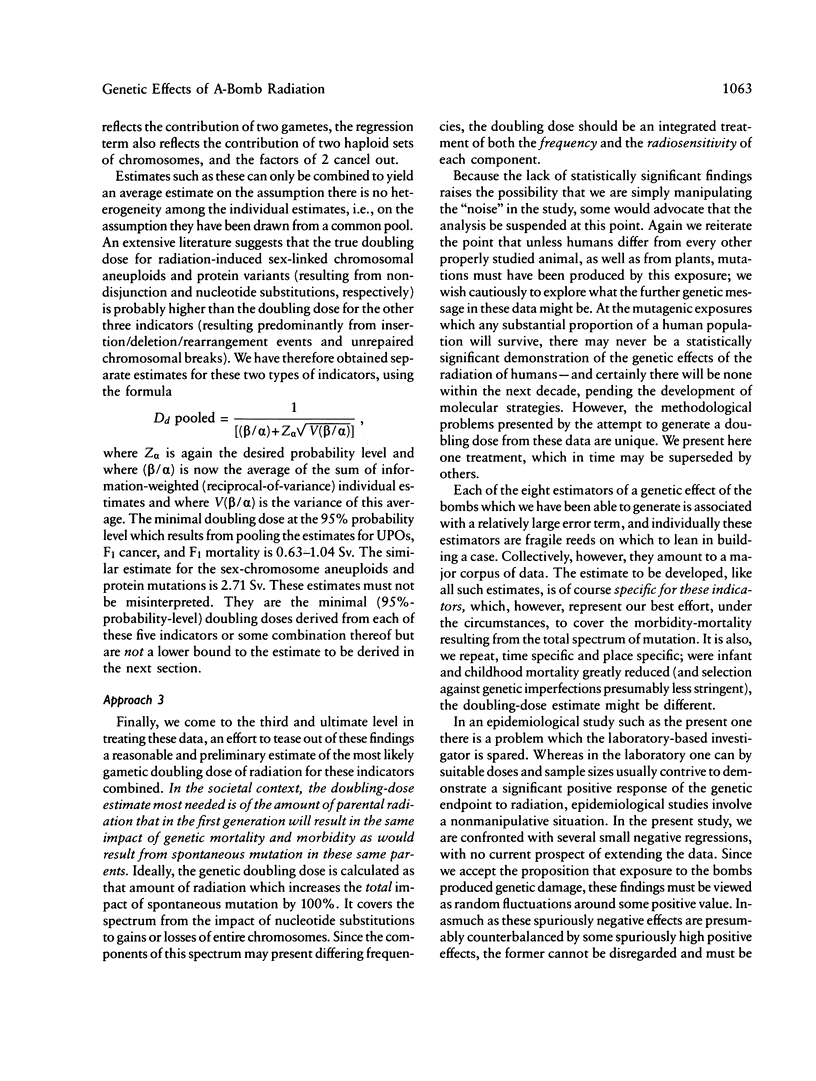

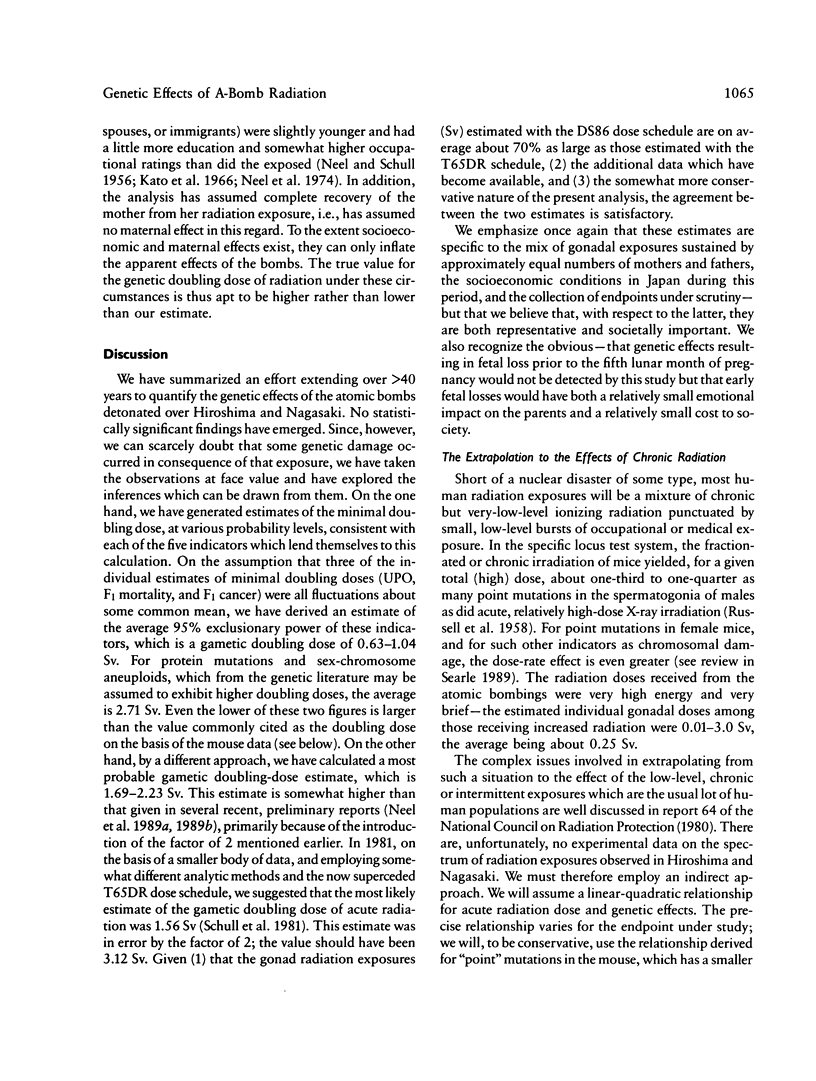
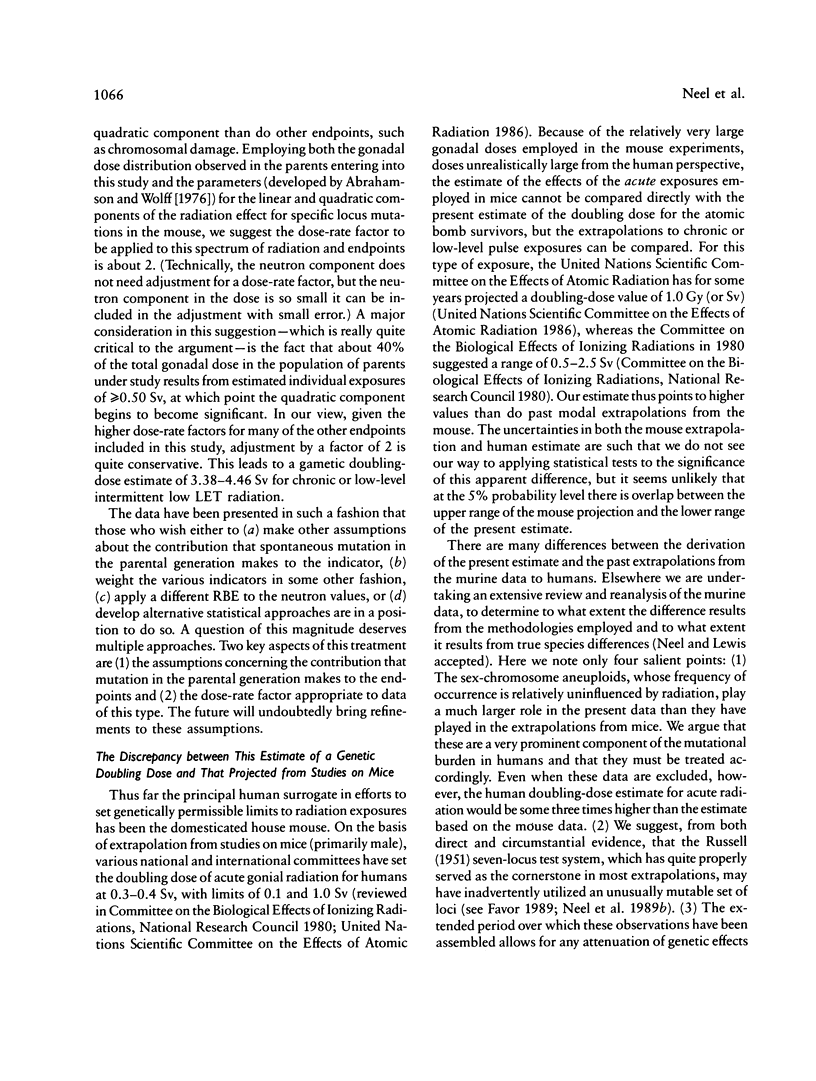
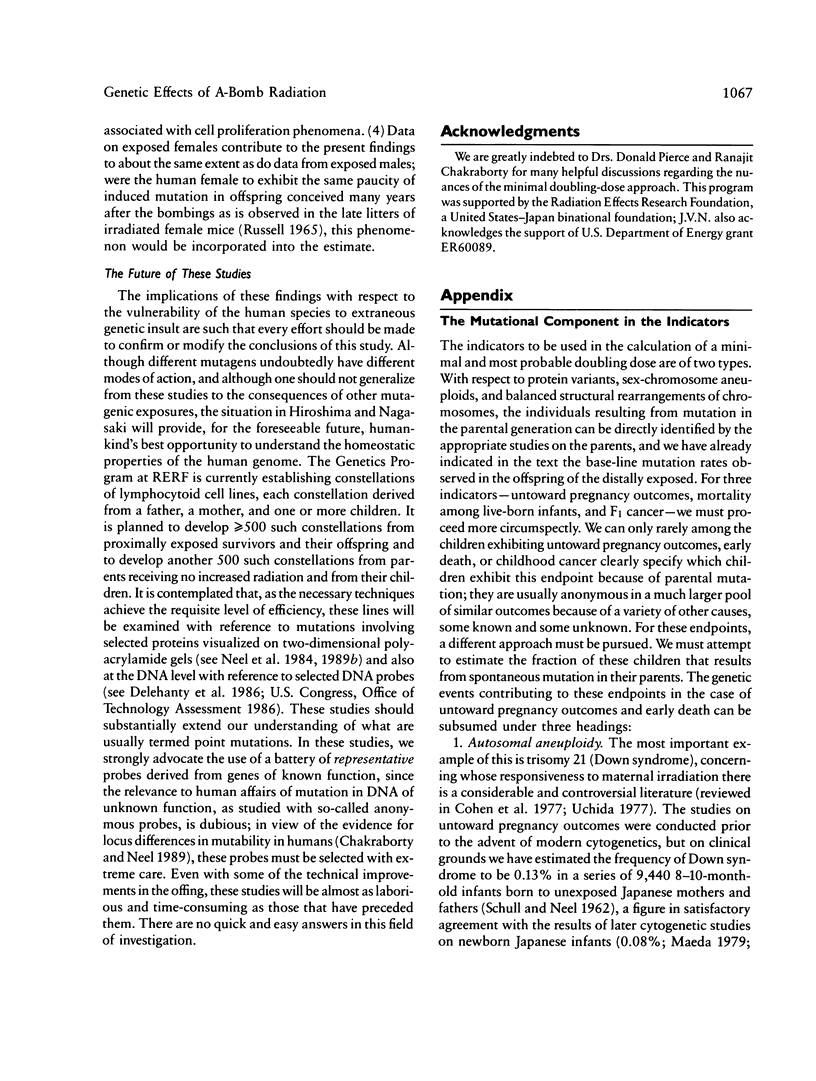
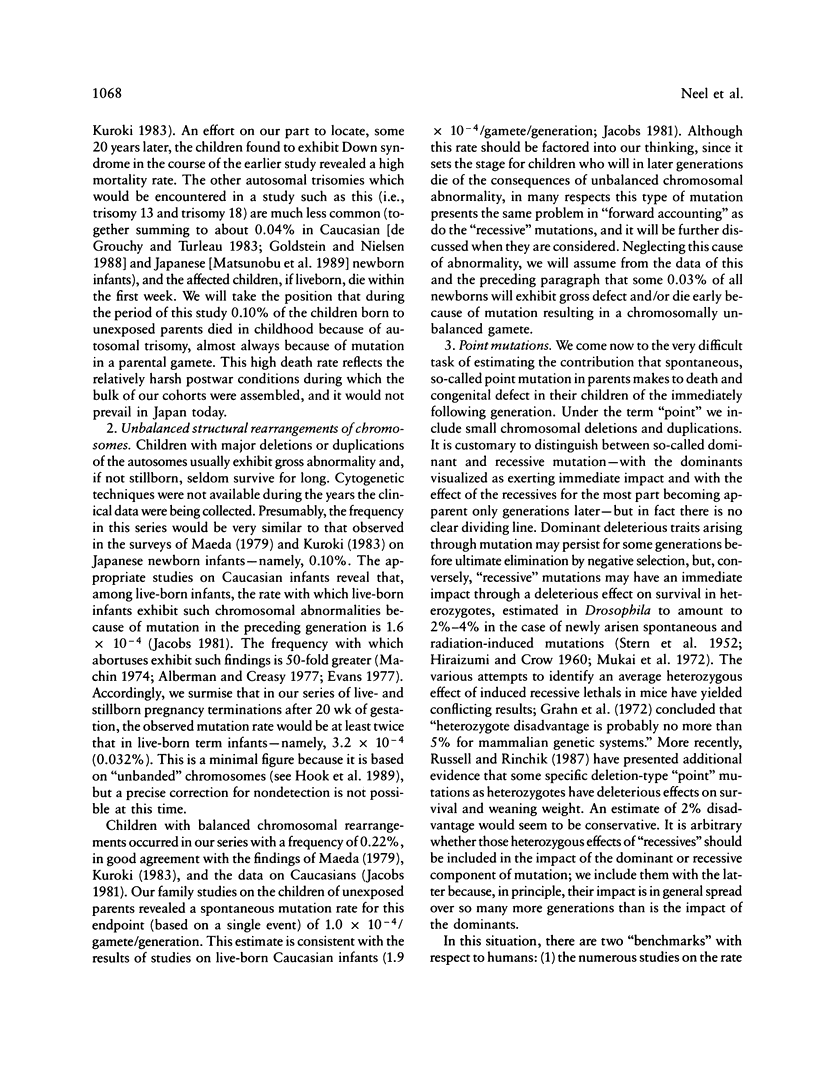

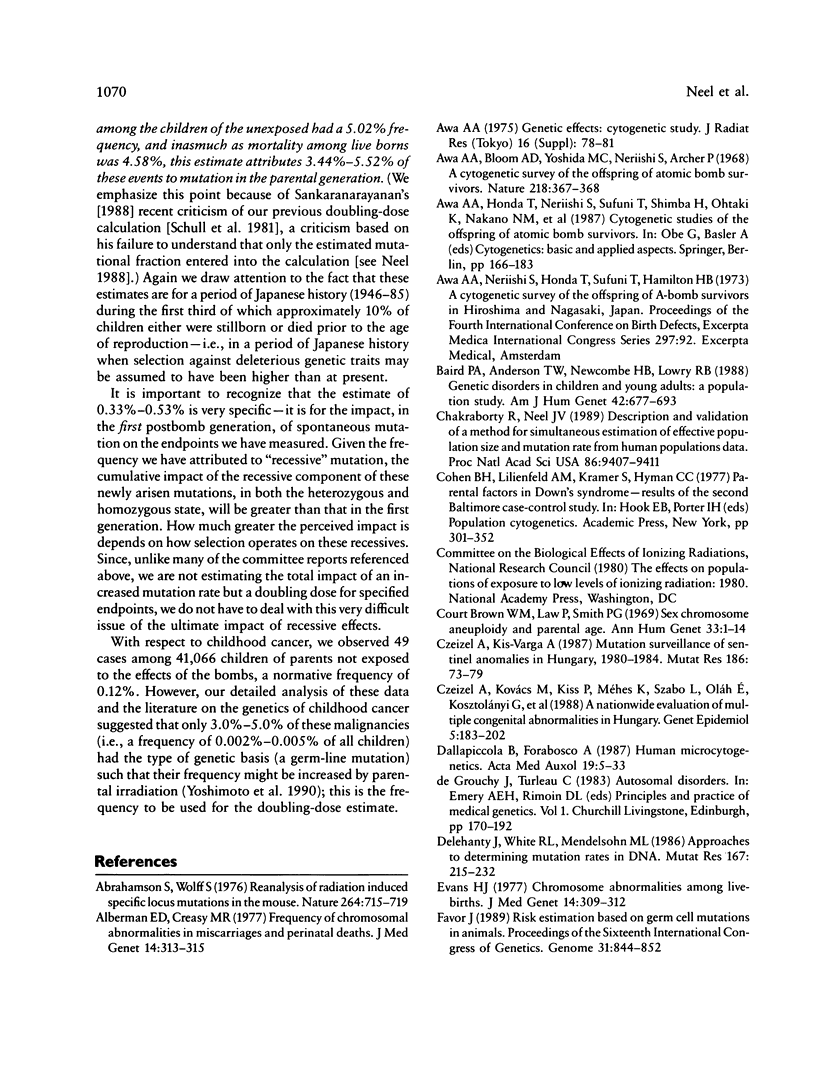
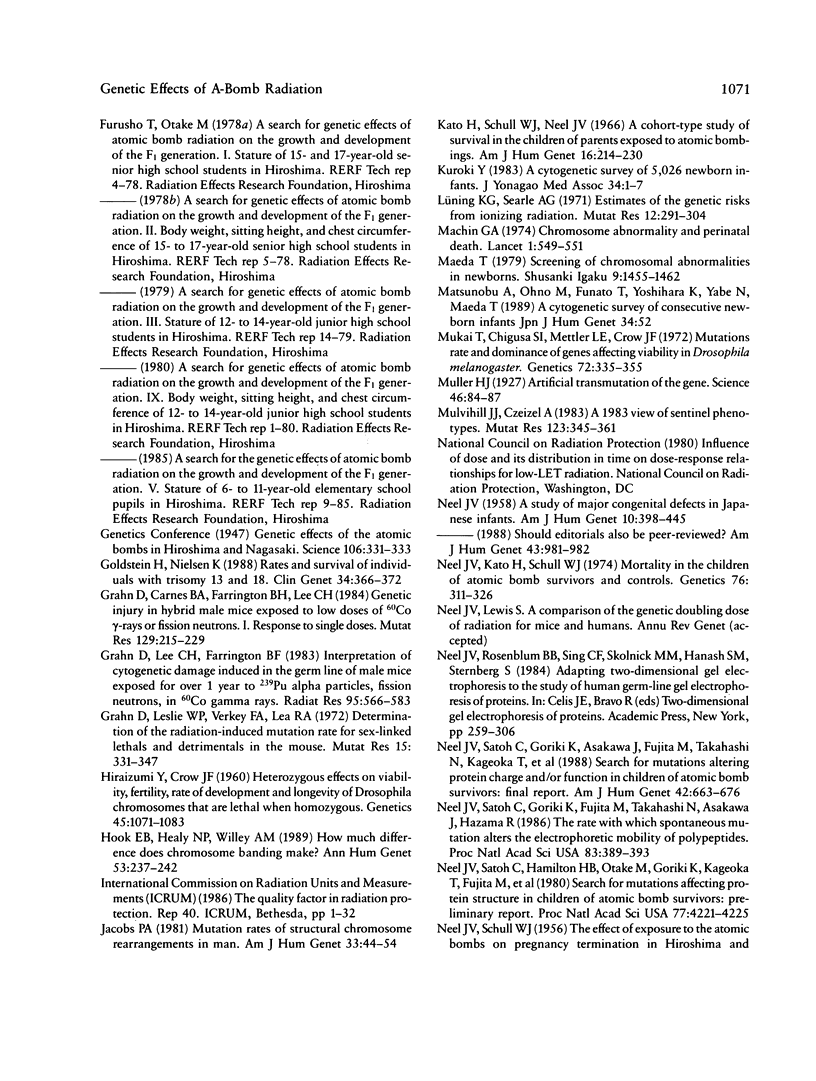
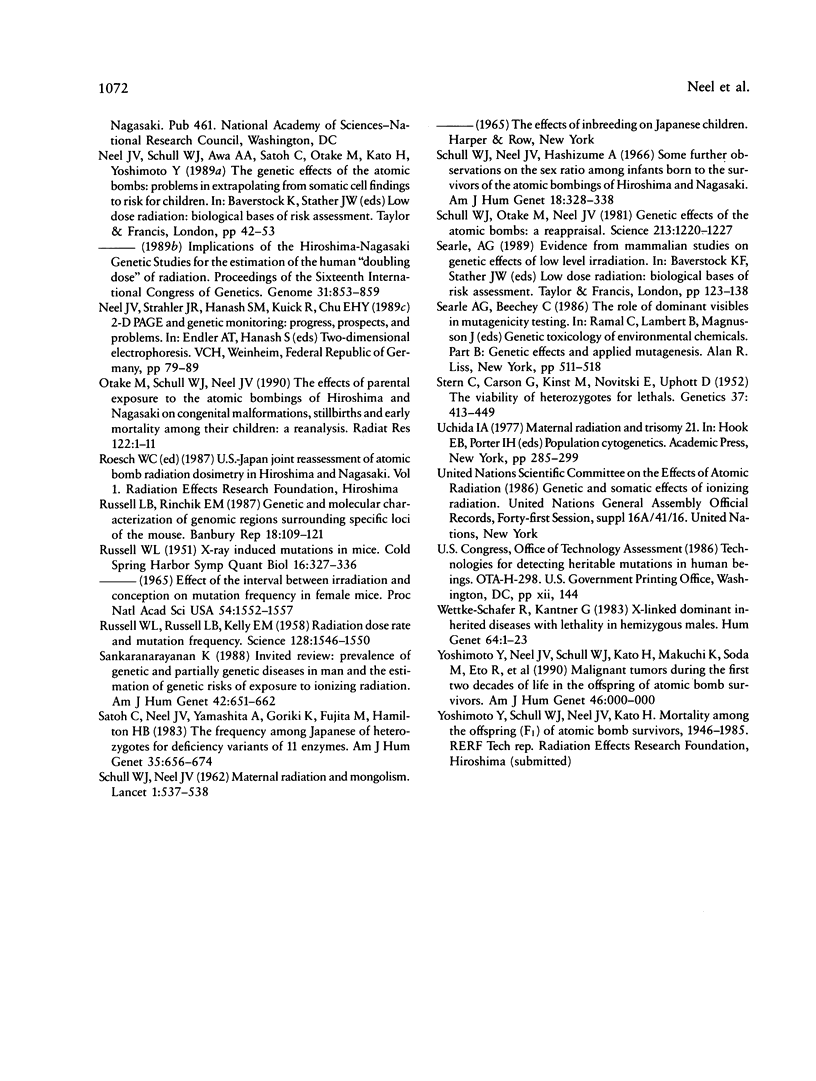
Selected References
These references are in PubMed. This may not be the complete list of references from this article.
- Abrahamson S., Wolff S. Re-analysis of radiation-induced specific locus mutations in the mouse. Nature. 1976 Dec 23;264(5588):715–719. doi: 10.1038/264715a0. [DOI] [PubMed] [Google Scholar]
- Alberman E. D., Creasy M. R. Frequency of chromosomal abnormalities in miscarriages and perinatal deaths. J Med Genet. 1977 Oct;14(5):313–315. doi: 10.1136/jmg.14.5.313. [DOI] [PMC free article] [PubMed] [Google Scholar]
- Awa A. A., Bloom A. D., Yoshida M. C., Meriishi S., Archer P. G. Cytogenetic study of the offspring of atom bomb survivors. Nature. 1968 Apr 27;218(5139):367–368. doi: 10.1038/218367a0. [DOI] [PubMed] [Google Scholar]
- Awa A. A. Review of thirty years study of Hiroshima and Nagasaki atomic bomb survivors. II. Biological effects. B. Genetic effects. 2. Cytogenetic study. J Radiat Res. 1975 Sep;16 (Suppl):75–81. doi: 10.1269/jrr.16.supplement_75. [DOI] [PubMed] [Google Scholar]
- Baird P. A., Anderson T. W., Newcombe H. B., Lowry R. B. Genetic disorders in children and young adults: a population study. Am J Hum Genet. 1988 May;42(5):677–693. [PMC free article] [PubMed] [Google Scholar]
- Brown W. M., Law P., Smith P. G. Sex chromosome aneuploidy and parental age. Ann Hum Genet. 1969 Jul;33(1):1–14. doi: 10.1111/j.1469-1809.1969.tb01623.x. [DOI] [PubMed] [Google Scholar]
- Chakraborty R., Neel J. V. Description and validation of a method for simultaneous estimation of effective population size and mutation rate from human population data. Proc Natl Acad Sci U S A. 1989 Dec;86(23):9407–9411. doi: 10.1073/pnas.86.23.9407. [DOI] [PMC free article] [PubMed] [Google Scholar]
- Czeizel A., Kis-Varga A. International Commission for Protection Against Environmental Mutagens and Carcinogens. ICPEMC working paper no. 4. Mutation surveillance of sentinel anomalies in Hungary, 1980-1984. Mutat Res. 1987 Jul;186(1):73–79. doi: 10.1016/0165-1110(87)90015-7. [DOI] [PubMed] [Google Scholar]
- Czeizel A., Kovács M., Kiss P., Méhes K., Szabo L., Oláh E., Kosztolányi G., Szemere G., Kovács H., Fekete G. A nationwide evaluation of multiple congenital abnormalities in Hungary. Genet Epidemiol. 1988;5(3):183–202. doi: 10.1002/gepi.1370050305. [DOI] [PubMed] [Google Scholar]
- Delehanty J., White R. L., Mendelsohn M. L. International Commission for Protection Against Environmental Mutagens and Carcinogens. ICPEMC Meeting Report No. 2. Approaches to determining mutation rates in human DNA. Mutat Res. 1986 May;167(3):215–232. doi: 10.1016/0165-1110(86)90031-x. [DOI] [PubMed] [Google Scholar]
- Evans H. J. Chromosome anomalies among livebirths. J Med Genet. 1977 Oct;14(5):309–312. doi: 10.1136/jmg.14.5.309. [DOI] [PMC free article] [PubMed] [Google Scholar]
- Favor J. Risk estimation based on germ-cell mutations in animals. Genome. 1989;31(2):844–852. doi: 10.1139/g89-149. [DOI] [PubMed] [Google Scholar]
- Goldstein H., Nielsen K. G. Rates and survival of individuals with trisomy 13 and 18. Data from a 10-year period in Denmark. Clin Genet. 1988 Dec;34(6):366–372. doi: 10.1111/j.1399-0004.1988.tb02894.x. [DOI] [PubMed] [Google Scholar]
- Grahn D., Carnes B. A., Farrington B. H., Lee C. H. Genetic injury in hybrid male mice exposed to low doses of 60Co gamma-rays or fission neutrons. I. Response to single doses. Mutat Res. 1984 Nov;129(2):215–229. doi: 10.1016/0027-5107(84)90154-4. [DOI] [PubMed] [Google Scholar]
- Grahn D., Lee C. H., Farrington B. F. Interpretation of cytogenetic damage induced in the germ line of male mice exposed for over 1 year to 239Pu alpha particles, fission neutrons, or 60Co gamma rays. Radiat Res. 1983 Sep;95(3):566–583. [PubMed] [Google Scholar]
- Grahn D., Leslie W. P., Verley F. A., Lea R. A. Determination of the radiation-induced mutation rate for sex-linked lethals and detrimentals in the mouse. Mutat Res. 1972 Jul;15(3):331–347. doi: 10.1016/0027-5107(72)90079-6. [DOI] [PubMed] [Google Scholar]
- Hiraizumi Y, Crow J F. Heterozygous Effects on Viability, Fertility, Rate of Development, and Longevity of Drosophila Chromosomes That Are Lethal When Homozygous. Genetics. 1960 Aug;45(8):1071–1083. doi: 10.1093/genetics/45.8.1071. [DOI] [PMC free article] [PubMed] [Google Scholar]
- Hook E. B., Healy N. P., Willey A. M. How much difference does chromosome banding make? Adjustments in prevalence and mutation rates of human structural cytogenetic abnormalities. Ann Hum Genet. 1989 Jul;53(Pt 3):237–242. doi: 10.1111/j.1469-1809.1989.tb01790.x. [DOI] [PubMed] [Google Scholar]
- Jacobs P. A. Mutation rates of structural chromosome rearrangements in man. Am J Hum Genet. 1981 Jan;33(1):44–54. [PMC free article] [PubMed] [Google Scholar]
- Lüning K. G., Searle A. G. Estimates of the genetic risks from ionizing irradiation. Mutat Res. 1971 Jul;12(3):291–304. doi: 10.1016/0027-5107(71)90017-0. [DOI] [PubMed] [Google Scholar]
- Machin G. A. Chromosome abnormality and perinatal death. Lancet. 1974 Mar 30;1(7857):549–551. doi: 10.1016/s0140-6736(74)92726-3. [DOI] [PubMed] [Google Scholar]
- Mukai T., Chigusa S. I., Mettler L. E., Crow J. F. Mutation rate and dominance of genes affecting viability in Drosophila melanogaster. Genetics. 1972 Oct;72(2):335–355. doi: 10.1093/genetics/72.2.335. [DOI] [PMC free article] [PubMed] [Google Scholar]
- Muller H. J. ARTIFICIAL TRANSMUTATION OF THE GENE. Science. 1927 Jul 22;66(1699):84–87. doi: 10.1126/science.66.1699.84. [DOI] [PubMed] [Google Scholar]
- Mulvihill J. J., Czeizel A. International Commission for Protection against Environmental Mutagens and Carcinogens. ICPEMC Working Paper 5/6. Perspectives in mutation epidemiology, 6. A 1983 view of sentinel phenotypes. Mutat Res. 1983 Dec;123(3):345–361. doi: 10.1016/0165-1110(83)90028-3. [DOI] [PubMed] [Google Scholar]
- NEEL J. V. A study of major congenital defects in Japanese infants. Am J Hum Genet. 1958 Dec;10(4):398–445. [PMC free article] [PubMed] [Google Scholar]
- Neel J. V., Kato H., Schull W. J. Mortality in the children of atomic bomb survivors and controls. Genetics. 1974 Feb;76(2):311–336. doi: 10.1093/genetics/76.2.311. [DOI] [PMC free article] [PubMed] [Google Scholar]
- Neel J. V., Satoh C., Goriki K., Asakawa J., Fujita M., Takahashi N., Kageoka T., Hazama R. Search for mutations altering protein charge and/or function in children of atomic bomb survivors: final report. Am J Hum Genet. 1988 May;42(5):663–676. [PMC free article] [PubMed] [Google Scholar]
- Neel J. V., Satoh C., Goriki K., Fujita M., Takahashi N., Asakawa J., Hazama R. The rate with which spontaneous mutation alters the electrophoretic mobility of polypeptides. Proc Natl Acad Sci U S A. 1986 Jan;83(2):389–393. doi: 10.1073/pnas.83.2.389. [DOI] [PMC free article] [PubMed] [Google Scholar]
- Neel J. V., Satoh C., Hamilton H. B., Otake M., Goriki K., Kageoka T., Fujita M., Neriishi S., Asakawa J. Search for mutations affecting protein structure in children of atomic bomb survivors: preliminary report. Proc Natl Acad Sci U S A. 1980 Jul;77(7):4221–4225. doi: 10.1073/pnas.77.7.4221. [DOI] [PMC free article] [PubMed] [Google Scholar]
- Otake M., Schull W. J., Neel J. V. Congenital malformations, stillbirths, and early mortality among the children of atomic bomb survivors: a reanalysis. Radiat Res. 1990 Apr;122(1):1–11. [PubMed] [Google Scholar]
- RUSSELL W. L., RUSSELL L. B., KELLY E. M. Radiation dose rate and mutation frequency. Science. 1958 Dec 19;128(3338):1546–1550. doi: 10.1126/science.128.3338.1546. [DOI] [PubMed] [Google Scholar]
- RUSSELL W. L. X-ray-induced mutations in mice. Cold Spring Harb Symp Quant Biol. 1951;16:327–336. doi: 10.1101/sqb.1951.016.01.024. [DOI] [PubMed] [Google Scholar]
- Sankaranarayanan K. Prevalence of genetic and partially genetic diseases in man and the estimation of genetic risks of exposure to ionizing radiation. Am J Hum Genet. 1988 May;42(5):651–662. [PMC free article] [PubMed] [Google Scholar]
- Satoh C., Neel J. V., Yamashita A., Goriki K., Fujita M., Hamilton H. B. The frequency among Japanese of heterozygotes for deficiency variants of 11 enzymes. Am J Hum Genet. 1983 Jul;35(4):656–674. [PMC free article] [PubMed] [Google Scholar]
- Schull W. J., Neel J. V., Hashizume A. Some further observations on the sex ratio among infants born to survivors of the atomic bombings of Hiroshima and Nagasaki. Am J Hum Genet. 1966 Jul;18(4):328–338. [PMC free article] [PubMed] [Google Scholar]
- Stern C., Carson G., Kinst M., Novitski E., Uphoff D. The Viability of Heterozygotes for Lethals. Genetics. 1952 Jul;37(4):413–449. doi: 10.1093/genetics/37.4.413. [DOI] [PMC free article] [PubMed] [Google Scholar]
- Wettke-Schäfer R., Kantner G. X-linked dominant inherited diseases with lethality in hemizygous males. Hum Genet. 1983;64(1):1–23. doi: 10.1007/BF00289472. [DOI] [PubMed] [Google Scholar]


